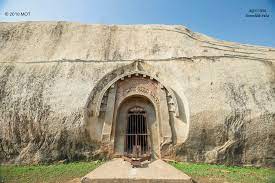Lomas Rishi Buddhist Cave – Bihar

Address
Lomas Rishi Buddhist Cave, Sultanpur Jehanabad district, Bihar – 804405
Diety
Buddha
Introduction
The Lomas Rishi Cave, also called the Grotto of Lomas Rishi, is one of the man-made Barabar Caves in the Barabar and Nagarjuni hills of Jehanabad district in the Indian state of Bihar. This rock-cut cave was carved out as a sanctuary. It was built during the Ashokan period of the Maurya Empire in the 3rd century BC, as part of the sacred architecture of the Ajivikas, an ancient religious and philosophical group of India that competed with Jainism and became extinct over time. The Cave is 30 kilometers (19 mi) north of Gaya in Bihar, an eastern state in India and about 1,500 kilometers (930 mi) from Ajanta Caves.
Puranic Significance
The cave of Lomas Rishi is probably the most famous of the caves of Barabar, because of its beautifully carved door. It is on the southern side of Barabar granite hill, and is adjacent to Sudama cave, which is on the left. Lomas Rishi consists of two rooms: a rectangular room measuring 9.86×5.18m and a circular, semi-hemispherical room 5m in diameter, which is accessed from the rectangular room by a narrow rectangular passage. This cave has an arched facade that probably imitates contemporary wooden architecture. On the periphery of the door, along the curve of the architrave, a line of elephants advances in the direction of stupa emblems. This is the characteristic form of the “Chaitya arch” or chandrashala, to be an important feature of architecture and sculpture in the rock for many centuries. It is clearly a stone reproduction of wooden buildings and other plant materials. According to Gupta, Lomas Rishi’s immediate successors are the Kondivite and Guntupalli caves. Lomas Rishi has no Ashoka inscription, perhaps because it has never been completed due to structural rock slide problems. It is generally considered, however, that it was also created around 260 BCE, like the other caves, because of the similarity of the internal structure and the degree of finish of the rock, the walls being perfectly polished, with the exception of the vault whose digging was interrupted. It has a much later inscription of Anantavarman above the entrance, from the 5th century CE.
Special Features
The hut-style facade at the entrance to the cave is the earliest survival of the ogee shaped “chaitya arch” or chandrashala that was to be an important feature of Indian rock-cut architecture and sculptural decoration for centuries. The form was clearly a reproduction in stone of buildings in wood and other vegetable materials. Lomas Rishi Cave is carved into the hard monolithic granite rock face of Barabar hills, flanked to its left by the smaller Sudama cave.
Century/Period/Age
3rd century
Managed By
Archaeological Survey of India (ASI) – Bihar
Nearest Bus Station
Sultanpur
Nearest Railway Station
Sultanpur Junction, Gaya
Nearest Airport
Allahabad




